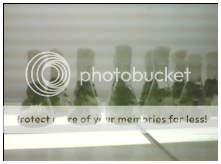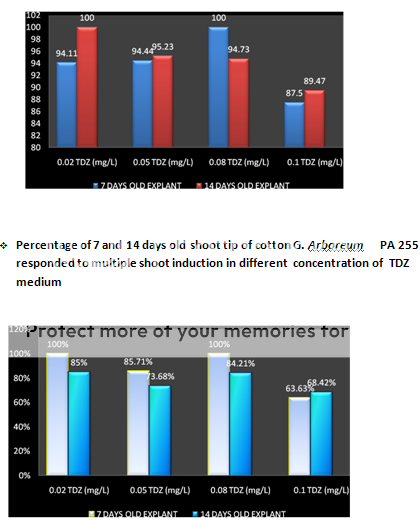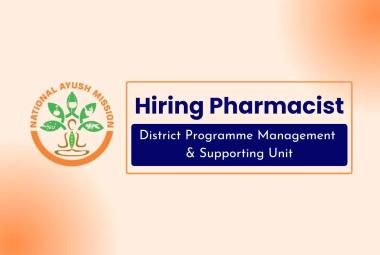About Authors:
Nitin Deorao Rewatkar
Department of Biotechnology, Kamla Nehru College,
Sakkardara Square, Nagpur
nitinrewatkar@gmail.com
Abstract
The effect of TDZ on regeneration studies of cotton G.arboreum cv PA255 was performed for in-vitro culture studies, healthy and disease free seeds, after surface sterilization were inoculated on seed germination media. Seeds germination efficiency was observed to be 73.38%. Shoot tips and cotynode explants aseptically isolated from in Vitro germinated seedlings of 7 and 14 days old were inoculated on MS basal salt supplemented with 30 gm/L glucose, 10 mg/L thiamine, 100 mg/L Inositol with four different concentration of TDZ. The proliferation of 7 and 14 days old shoot tip was found to 100% in media combination with 0.08 TDZ and 0.02 TDZ respectively. Cotynode explants of 7 days old was 100% responded in 0.02 TDZ and 0.08 TDZ, 14 days old cotynode shows highest 85% explants responded in 0.02 TDZ media combination but multiple shoots observed higher in 0.05 TDZ medium.TDZ induces callus formation and inhibit root formation, TDZ shows good responsein very small concentration otherwise increase concentration more than 1 mg/l it shows toxic effect on explants and completely dried. Browning and subsequent death of the cultured explants are major problems in TDZ supplemented media. Calculate the amount of phenol excreted from shoot tip and cotynode during in vitro regeneration of cotton cv. PA255. In the media combination 0.1mg /L TDZ evaluate highest phenol secreted, shoot tip secrete average 0.014mg and cotynode secrete 0.022mg phenol by per explants.
Reference Id: PHARMATUTOR-ART-1414
Abbreviation : TDZ- Thiodiazuron,
Introduction
The field of plant biotechnology is concerned with developing ways to improve the production and productivity of plants in order to meal the world’s needs for food, fiber and fuel. As our population grows, our needs also grow. But land under cultivation remains the same. Therefore with the help of Plant tissue culture technique can be improved for better production. Tissue culture in combination of genetic engineering has helped to produce large number of transgenic plant for biotic stress resistance and improve quality Cotton is known as a white gold because it is important cash crop of global significance which is cultivated in tropical & subtropical region of more than 70 countries the world over. The major producers of cotton are USA, China, India, Pakistan, Uzbekistan, Brazil, Mexican and Turkey. These countries contribute about 85% to the global cotton production. 111.
Through the use of biotechnology, desirable genetic traits can be transferred from one organism to another by transfer of DNA. Many more plants with the desirable DNA can be regenerated from small pieces of the transformed plant tissue. Due to the economic importance of cotton through genetic engineering, a great deal of effort has been made to develop systems to recover fertile transgenic cotton plants (Aragaro et al, 2005). Thus there is considerable interest in the development of tissue culture and gene transfer protocol in this species. Cotton as such is relatively difficult for in- vitro culture. Initially efforts were made to transform cotton using Agrobacterium tumefaciens and first transgenic cotton was developed (Firoza bady et al, 1987), and (perlak et al 1987). The transgenic cotton developed by these workers were later commercialized in USA and rest of this countries cultivar showing regeneration of cotton by somatic embryogenesis are few and mostly related to coker genotypes. 22
There have been reports that genotypes other than coker have also been tried to investigate by somatic embryogenesis (Zhao et al 1996) .Though most of the genotypes showed low frequency of somatic embryogenesis, the embryos are either abnormal or not mature prosperity, therefore low rate of germination of genotypes these was genotype specific and even seedlings specific (Trolinder and xhixian 1989) 33
Direct shoot regeneration is another approach for plant regeneration Gould et al(1991), (Nandeshwar 1995) Nandeshwar et al (2002) have reported regeneration by shoot tip explants and explain the possibility of using this protocol in genetic transformation Agrawal et al (1997) used cotyledonary node and shoot tip are regenerated cotton plants by direct shoot organogenesis or multiple shoot induction .It has been observed that incidence of genetic mutation and somaclonal variations are low as compare to plants regenerated by somatic embriyogenesis (Gould et al 1991, 1997), Nandeshwar et al,2002) 44
One of the most important factors for transformation in plants is the establishment of an efficient regeneration protocol of cells and/or tissues. In the specific case of cotton, most of the genotypes of commercial interest present problems of plant regeneration through callus or cells in suspension (Bayley et al., 1992). It has been considered a recalcitrant species to in vitro proliferation (Gupta et al., 1997). Therefore, improvement of methods of Regeneration in vitro is necessary to make viable research on transformation and regeneration of this species.55
Thiodiazuron (TDZ) is one of the various kinds of substituted urea that has been investigated for induction of multiple shoots in plants. Although it has been initially developed as an herbicide, its use as a growth regulator in woody species in vitro is considered one of the most positive innovations in tissue culture during the last few years (Huetteman and Preece, 1993). There are several reports about the positive effects of TDZ in the proliferation of auxiliary shoots. Huettman and Preece (1993) reported results by several authors from various species, in which positive effects of TDZ to the culture medium have been observed. Bhagwat et al. (1996) obtained multiple shoots of cassava from nodal explants by exposition to TDZ with concentrations ranging from 0.11 to 0.22 μM in liquid medium for 6 to 8 days. 66
Browning and subsequent death of the cultured explants are major problems for many tissue culture non hard-adaptive species and usually dependant on the phenolic compounds and the quantity of total phenols many studies, using shoot tip as explants source indicated various problem such as phenol exudation, media discoloration, rooting deficiencies and explants browning and death. 77
The phenol is synthesized by the plants and in many tissue culture studies, excreted and the oxidized phenol effect in vitro proliferation negatively. In addition, amount of phenols can be more or less in different stages of organogenesis due to metabolic actions.
Therefore determination of phenols and calculating, the amount of phenols may be another research area for many tissue culture studies. In this study, phenol amount of shoot tip and cotynode leached in media were evaluating during in vitro of regeneration of cotton PA255 Singleton-Rossi method based folin-ciocalteu reagent was used for determination of total phenol concentration of the media.
Methods
In-vitro seed germination
Seed sterilization
Seeds of good quality were selected and taken in a conical flask and washed with tap water for five min .To this was then added autoclaved DD water with few drops of liquid detergent agitated for few min followed by 3-4 washes with DD water. Seeds were then transferred in the flask containing Bavistin solution (1% w/v) and kept on orbital shaker for 20 min .this was again washed with autoclaved DDW 3-4 time till the trace of bavistin is completely removed . The seeds were then treated with HgCl2 solution (0.1%) for 7 min, washed 4-5 times and inoculated in the flask containing of half MS at the rate of 15-20 seeds /flask.

Fig. Seven days old germinated seedlings
Isolation of explants
The explants were isolated from 7 and 14 days old in-vitro germinated seedlings .These explants were excised aseptically in laminar air flow cabinet. Shoot tip explants were isolated by first removing both the cotyledonary leaf was removed by scalpel and forceps. The growing tip along with 0.5 mm long hypocotyl portion were cut and collected in sterile petriplates. Cotynode explants were isolated by removing both cotyledonary leaf and apical meristem portion was removed by scalpel and forceps. The nodal portion along with 0.5 mm long hypocotyl were cut then inoculated in MS basal composition with the following concentration of TDZ: 0.02, 0.05, 0.08 and 0.1 mg/L TDZ, then culture flask kept under controlled condition and monitored daily to avoid contamination. The explants responded to multiple shoots and number of multiple shoots observed per explants was calculated.
Isolation of phenol from media secreted by explants
In this study shoot tip and cotynode of 7 days old seedlings of PA 255 were cultured in 0.02, 0.05, 0.08 and 0.1mg/L TDZ. After 40 days explants were subculture, excreted phenols from explants to medium were isolated from media. Add 95% ethanol in media keep it in oven on 80o C for 20 min. After that mix ethanol with media, with the help of glass rod. Keep it room temperature for 1 hrs. Then filter the solution by using muslin cloth. Filtrate solution stored in freezer for 1 hrs. Then centrifuge the solution approximately 3000 rpm for 10 min. Take supernatant and stored it in freezer. Then 1 ml of supernatant was transferred to a test tube and 2 ml double distilled water was added. 0.5 ml (50%) of Folin-Ciocalteu solution reagent was added to each sample. After 3 min, 2 ml of 20 % Na2CO3 was added, the samples were mixed and allowed to stand for few min and measured O.D. at 680 nm using colorimeter, reading standardize against catechol (0.01mg/ml) as a standard.
Results and discussions
Shoot tip explants of G. arboreum CV PA 255
In the present study, multiple shoots proliferation was rapid in combination containing 0.08 TDZ from shoot tip of 7 days old seedlings of PA255 as compared to other concentration of TDZ; it shows 100% explants responded to multiple shoots, average 6.67 multiple shoots per explants observed after 25 days of inoculation. Multiple shoot proliferation from shoot tip of 14 days old seedlings highest in combination of MS with 0.02 TDZ was 100% than other concentration of TDZ it shows 7.85 multiple shoots per explants, while increase the concentration of TDZ shows less multiple shoots, in 1.0 TDZ mg/l concentration explants were completely dried.
Table 1. In-vitro response of multiple shoots induction in 7 and 14 days old shoot tip explants of cotton G. Arboreum PA255
|
Concentration Of TDZ.(mg/L |
% of explants Responded |
No. of multiple shoots observed per explants after 25 days |
||
|
7 days old |
14 days old |
7 days old |
14 days old |
|
|
0.02 TDZ |
94.11 |
100 |
2.81 |
7.85 |
|
0.05 TDZ |
94.44 |
95.23 |
5.66 |
6.95 |
|
0.08 TDZ |
100 |
94.73 |
6.67 |
5.57 |
|
0.1 TDZ |
87.50 |
89.47 |
4.08 |
4.25 |
Cotynode explants of G. Arboreum CV PA 255
Where as proliferation of multiple shoot in cotynode of 7 days old seedlings was highest in 0.02 mg/l TDZ and 0.08mg/l TDZ with MS media, it was found to be 100% explants responded to multiple shoots, highest multiple shoots was observed in 0.05 TDZ it shows average 8.99 multiple shoots per explants after 25 days. The average multiple shoots observed more in 0.05 and 0.08 TDZ combination, in 0.02 TDZ only length of explants were increase and observed low multiple shoots.
Where as multiple shoots proliferation in cotynode from 14 days old seedlings of PA255 was highest in 0.02 TDZ with MS media, it was found to be 85%. It shows 6.20 multiple shoots per explants after 25 days of inoculation. In 0.05 TDZ 73.68%, in 0.08 84.21% and in 0.1TDZ 68.42% explants was responded to multiple shoot induction. 7 days and 14 days old shoot tip and cotynode explants respond for multiple shoots as well as callus induction, on the cut end of explants shows callus formation.
Table 2. In-vitro response of multiple shoots induction in 7 and 14 days old cotynode explants of cotton G. Arboreum PA255
|
Concentration of TDZ.(mg/L |
% of explants Responded |
No. of multiple shoots observed per explants after 25 days |
||
|
7 days old |
14 days old |
7 days old |
14 days old |
|
|
0.02 TDZ |
100 |
85 |
5.43 |
6.20 |
|
0.05 TDZ |
85.71 |
73.68 |
8.99 |
6.20 |
|
0.08 TDZ |
100 |
84.21 |
7.16 |
3.62 |
|
0.1 TDZ |
63.63 |
68.42 |
5.33 |
4.66 |
* Percentage of 7 and 14 days old shoot tip of cotton G. Arboreum PA255 responded to multiple shoot induction in different concentration of TDZ medium

Estimation of phenol secreted in media
In this study browning of media is major problems, discoloration of media due to phenolic compound secreted by cut end of explants .phenol secretion was more in TDZ supplemented media than other plant growth regulator, its adverse effect on regeneration of cotton. More amount of phenol in media inhibits the multiple shoots and died the explants. After 40 days of inoculation of explants, subculture the explants in same media combination, isolate phenols from media and estimate by Singleton-Rossimethod based Folin-Ciocaelteu reactive was used for determination of phenol secreted by per explants. Total phenol present in culture bottle containing media and divided by numbers of explants were cultured in that culture bottle and estimate average phenols secreted by per explants. Table 5. shows that increase the concentration of TDZ therefore increase the amount of phenol. Table shows that cotynode explants secrete more phenols than shoot tip explants.
Table 3. Estimation of phenol from Shoot tip and cotynode
|
Sample |
Concentration of phenol average secreted by per explants |
|
|
Shoot tip |
cotynode |
|
|
0.02 TDZ |
0.011mg |
0.016mg |
|
0.05 TDZ |
0.012mg |
0.014mg |
|
0.08 TDZ |
0.012mg |
0.022mg |
|
0.1 TDZ |
0.014mg |
0.022mg |
Reference
• Michol Fabina et al (1991). Regeneration of G- hirsutum and G. barbadence from short apex tissue for transformation plant cell reports 10 : 12 – 16.
• Nandeshwar S.B., (1995). Regeneration of cotton G. hirsutum from shoot tip culture.
• Agrawal et al (1997). Induced multiple shoots and plant regeneration in cotton G. hirsutum CV LRK-516.
• Hemphill (1997). Developed a protocol for rapid in-vitro regeneration in G. hirsutum L.
• Gupta et al. (1997). Obtained in-vitro proliferation of shoots and regeneration of 8 cultivars of G. hirsutum and 2 of G. arboretum cotton.
• Morre et al. (1998). Showed multiple shoot induction & plant regeneration from embryogeni axes of cotton.
• Angelova Y, Petkova S, Zozikova E, Kotseva E, Iliev L (2001). Effects of kinetin and 4PU-30 on the growth and the content of polyphenols in tobacco callus tissue. Bulgar. J. Plant Physiol. 27(1-2): 36-42
• Banerjee, A.K. Agrawal K.V. (2003). Multiple shoot induction and plant regeneration from embryo axes.
Mishra R, Wang H, Yadav NR, Wilkins TA (2003). Development of highly regenerable elite Acala cotton (Gossypium hirsutum cv. Maxxa) - a step towards genotype-independent regeneration. Plant Cell, Tissue Organ Cult. 73: 21-35.
• Saeed Rauf et al (2004) Effect of kinetin on multiple shoot induction in cotton G. hirsutum CV. NIAB-999, Iranian journal of biotechnology vol-2, no-4.
• Bushra Rashid et al (2004). In vitro shoot tip culture of cotton G. hirsutum pak. Journal. Bot 36 (9) : 817-823
• Mohammad usman et al (2005). In vitro regeneration and multiple shoot induction in upland cotton G. hirsutum. Plant tissue cell 15(1) : 75-81.
• Ozyigit II, Kahraman MV, Ercan O (2007). Relation between explants age, total phenols and regeneration response of tissue cultured cotton (Gossypium hirsutum L.). Afr. J. Biotechnol, 6(1): 3-8.
• Khalaf Alla and Eltayb Abdellatee (2008). In vitro multiple shoot induction and plant regeneration in elite sudaness, cotton G. hirsutum cultivar barac-B-67. Journal innov. Dev,. Strategy 2(3): 77-82.
• Firoozeh Chamandosti (2010). The relationship between plant Growth regulator for organogenesis and phenolics Compound in Cotton (G. hirsutum L.) Asian journal of Development Biology 2(1): 16-22
NOW YOU CAN ALSO PUBLISH YOUR ARTICLE ONLINE.
SUBMIT YOUR ARTICLE/PROJECT AT articles@pharmatutor.org
Subscribe to Pharmatutor Alerts by Email
FIND OUT MORE ARTICLES AT OUR DATABASE









